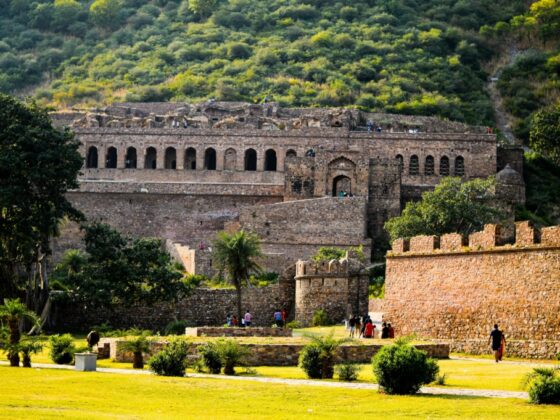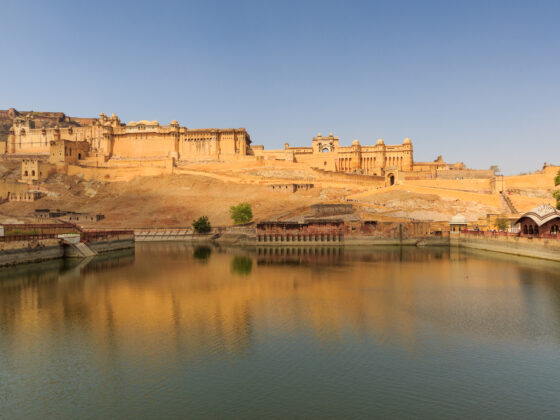Introduction
Tucked away in the heart of Madhya Pradesh, the former princely state of Rajgarh holds a rich architectural legacy shaped by its royal rulers. Known for their valiant spirit and deep cultural values, the Rajgarh royal family left behind awe-inspiring structures—forts that guarded the land, palaces that defined elegance, and temples that stood as pillars of devotion. These monuments not only narrate stories of a bygone era but also symbolize the identity and pride of Rajgarh’s historical landscape. The Rajgarh royal family architecture blends Rajput strength with spiritual elegance, seen in its forts, palaces, and centuries-old temples.

The Majestic Rajgarh Fort
Dominating the skyline of the town, the Rajgarh Fort served as a formidable stronghold for the ruling Umath Rajputs. Constructed on a hilltop, its strategic position provided panoramic views of the surrounding plains, allowing for surveillance and defense.
Highlights of the Fort:
-
Constructed using robust stone masonry, the fort featured thick walls and bastions built for battle-readiness.
-
Architectural elements include arched gateways, elevated watchtowers, and traditional Rajput motifs.
-
An ancient water harvesting system, including stepwells and cisterns, ensured self-sufficiency during long sieges.
While time has weathered parts of the structure, the fort still stands as a tribute to the foresight and tactical strength of the Rajgarh rulers.
Rajgarh Palace – A Symbol of Royal Grandeur
Unlike the fort, which symbolized power, the Rajgarh Palace epitomized luxury, beauty, and refined taste. This residence was built to host court gatherings, royal festivities, and diplomatic meetings.
Distinctive Features:
-
The palace architecture fused Rajput and Indo-Islamic design elements, visible in its domes, jharokhas (balconies), and finely carved pillars.
-
Lavishly decorated interiors included mirror-worked halls, painted ceilings, and ornamental stucco reliefs.
-
Expansive courtyards, lotus ponds, and manicured gardens reflected the Mughal influence and the royal family’s aesthetic sensibilities.
Though no longer used as a royal dwelling, parts of the palace are preserved and continue to inspire visitors with a glimpse into Rajgarh’s regal past.
Sacred Spaces – The Temples of Rajgarh
Religion shaped Rajgarh’s history deeply, as the royal family actively commissioned spiritual architecture across the region. The dynasty especially revered Lord Narsingh and Lord Shiva, building temples and patronizing rituals in their honor.
Notable Temples:
-
Narsingh Mandir, located in Rajgarh town, is a vibrant center of worship known for its annual celebrations and festivals.
-
Shiv Mandir, located near the fort, served as a private temple for the royal family and was likely the site of spiritual rituals before battle.
The intricate carvings, stone idols, and ancient inscriptions at these temples offer insight into the devotional practices and patronage of the Rajgarh royals. They remain active places of worship, connecting today’s devotees with centuries-old traditions.
Lesser-Known Architectural Treasures
Beyond the main palaces and temples, Rajgarh is dotted with historical gems that often go unnoticed:
-
Chhatris, or royal cenotaphs, commemorate the valor and memory of Rajgarh rulers and warriors.
-
Stepwells, once vital for water conservation, also served as cool retreats during harsh summers.
-
Hunting lodges, watchtowers, and small shrines located in the surrounding countryside highlight the royal family’s blend of practicality and devotion.
Many of these structures are awaiting restoration, and heritage enthusiasts are working to document and preserve them for future generations.
Reviving the Past – Conservation and Tourism
There’s a growing recognition of the importance of preserving Rajgarh’s architectural legacy:
-
Local initiatives, including heritage walks and guided tours, are helping to spread awareness.
-
Descendants of the royal family and local historians are advocating for conservation grants and government recognition of the Rajgarh Fort and other structures.
-
Some organizations have proposed converting parts of the fort and palace into cultural museums or boutique stays, tapping into heritage tourism.
These steps can help generate employment, educate visitors, and sustain the historic essence of Rajgarh.
Architectural Influence Across Regions
The design principles seen in Rajgarh’s heritage structures found their way into neighboring regions such as Bhopal, Khilchipur, and Narsinghgarh. Elements like decorative brackets, jharokhas, multifoil arches, and chhatris influenced temple and palace designs in surrounding states.
Today, even modern buildings in Rajgarh retain echoes of this royal architectural language—be it in carved wooden doors, courtyard layouts, or shrine placements within homes.
Conclusion – Living Legacy in Stone
The architectural wonders of Rajgarh are more than ruins—they reflect identity, artistry, and faith. The forts tell stories of defense. The palaces show elegance and royal life. The temples still echo ancient prayers.
Preserving these structures isn’t merely about stone and mortar—it’s about honoring a culture, a lineage, and a shared memory. For anyone connected to or inspired by the Rajgarh royal family, these monuments offer a window into the glorious and grounded world their ancestors helped build. Rajgarh royal family architecture showcases a timeless blend of regal grandeur, spiritual devotion, and Rajput craftsmanship.








